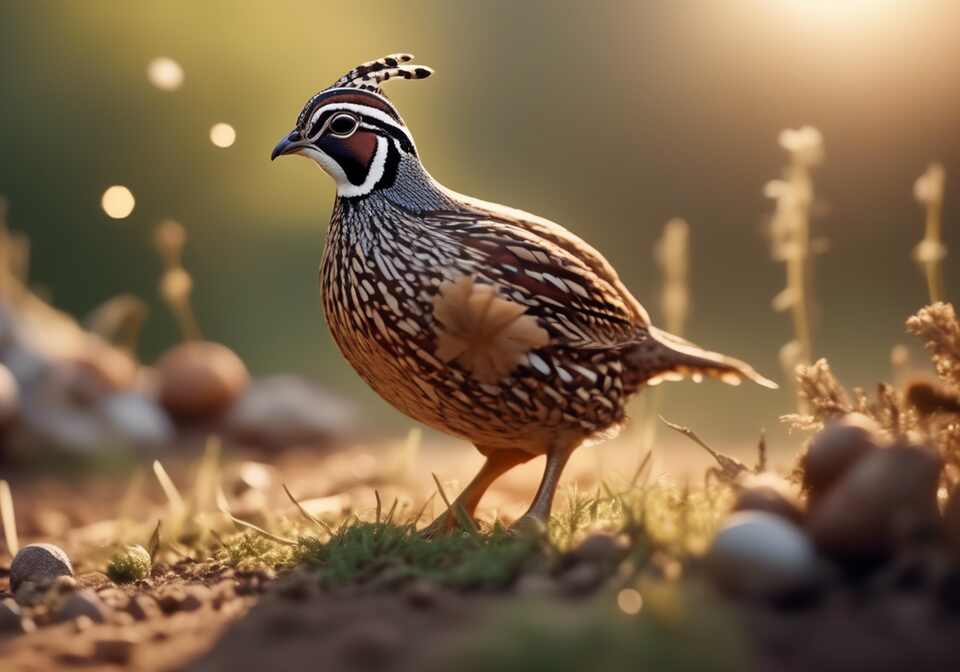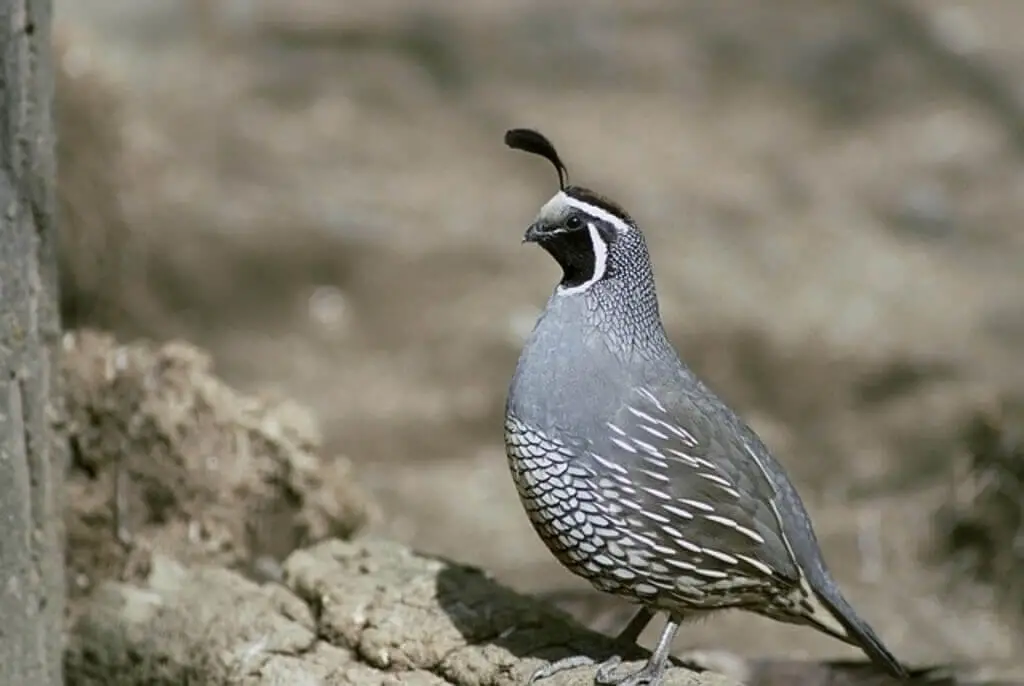
Quail are charming birds known for their distinctive appearance and delightful presence in yards and gardens. To attract these lovely creatures to your yard, implementing specific strategies can make a significant difference. Here are some effective methods to entice quail to visit and dwell in your outdoor space.
Table of Contents
Quail Characteristics & Distribution
Identifying Quails
Quail are small, plump birds that are similar to chickens. They live in the wild and have adapted well to living in areas with humans, as they often eat from human-provided food sources such as gardens and trash cans. Quail do not fly very well, but they can jump or run long distances.
- Males: Gray and brown with a black face and a white band around the face.
- Females: Brown with no facial markings. Both sexes have a white belly with a scaly reddish-brown pattern on it, which is also seen on their back and wings when they fly away.
- Size: 15–19 cm (5.9–7.5 in) in length, 30–36 cm (11.9–14.1 in) wingspan, and weigh between 68 to 142 g (2.4 to 5.0 oz).
- Sounds: Quail make chirping sounds in flight to keep track of each other during migration.
- Feathers: Their feathers have a lot of shine due to the barbs running lengthwise along the shafts, giving them a wet or greasy appearance.
Distribution Range
Quail can be found in the United States, Canada, Mexico, Europe, and Asia. The range of quail extends across these countries and parts of Central America, such as Costa Rica and Panama.
- California quail: California, Washington, Oregon, Southeastern Idaho, Nevada, and Northern Utah.
- Gambel’s quail: Desert regions of Arizona, California, Colorado, New Mexico, Nevada, Utah, Texas, and Sonora.
- Northern bobwhite: Eastern North America.
- Mountain quail: West of the Rocky Mountains.
- Montezuma quail: Southwestern US and Mexico.
- Scaled quail: Arizona, Northern New Mexico, Colorado, Kansas, Oklahoma, Texas, Mexico.
Strategies for Attracting Quail to Your Yard
Understanding Quail Behavior
Before you start making changes to your yard, it’s essential to understand quail behavior. Quail are ground-dwelling birds that prefer areas with low-growing vegetation where they can forage for food and seek protection from predators. They are social birds that typically move around in small groups known as coveys. By creating a habitat that simulates their natural environment, you can encourage quail to frequent your yard.
Providing Suitable Shelter and Habitat
Quail seek areas with adequate cover and shelter. To attract quail to your yard, create a suitable habitat by incorporating dense shrubs, bushes, and grassy areas. These features offer quail protection from predators and harsh weather conditions, making them feel safe and secure in your yard.
- Dense Vegetation: Plant low-growing shrubs, grasses, and wildflowers. These plants provide cover for quail and safe places to build nests and raise chicks. Examples include native grasses like switchgrass and shrubs like American hazelnut.
- Natural Materials: Construct brush piles, use logs, or create rock piles to offer additional cover and nesting sites.
Offering Food and Water Sources
Quail have specific dietary preferences, including seeds, grains, insects, and various plants. To attract quail to your yard, consider setting up bird feeders with a mix of seeds and grains that are appealing to these birds. Additionally, providing a source of fresh water, such as a birdbath or shallow dish, can attract quail looking to hydrate and bathe.
- Seed Mixes: Use millet, cracked corn, sunflower seeds, and safflower in feeders. Scatter some seeds on the ground to mimic natural foraging.
- Insect-Rich Areas: Maintain a part of your garden with native plants that attract insects, providing a natural food source for quail.
- Water Sources: Ensure water sources are shallow and clean to attract quail. Adding a small, dribbling fountain or water feature can make your yard more appealing. Consider using high-quality products like the Esschert Design Cement Bird Bath available on Amazon, perfect for providing a refreshing water source for your feathered visitors.
Avoiding Chemicals and Pesticides
Quail are sensitive birds that can be negatively affected by chemicals and pesticides used in yards and gardens. To create a quail-friendly environment, opt for natural and organic methods of pest control and avoid using harmful chemicals. This approach not only benefits quail but also promotes a healthier ecosystem in your yard.
- Organic Gardening: Use compost and natural fertilizers. Introduce beneficial insects like ladybugs to control pests.
- Natural Pest Control: Utilize neem oil, insecticidal soaps, and diatomaceous earth as safe alternatives to chemical pesticides.
Creating Nesting Sites
Quail build their nests on the ground in hidden locations to protect their eggs and offspring. To attract quail for breeding and nesting, leave areas of your yard undisturbed, with patches of tall grass or brush where these birds can conceal their nests. By providing suitable nesting sites, you invite quail to raise their young in the safety of your yard.
- Nesting Boxes: Place ground-level nesting boxes in quiet, undisturbed areas. These boxes should be discreet and blend with the surroundings. Consider using high-quality nesting boxes like this one by Little Giant available on Amazon, designed specifically for ground-dwelling birds.
- Natural Nests: Ensure there are plenty of undisturbed, dense areas with grasses and shrubs where quail can create their nests.
Minimizing Disturbances and Predators
Quail are easily startled by loud noises, sudden movements, and the presence of predators. To attract quail to your yard, minimize disturbances by avoiding excessive noise and movements around their habitat. Additionally, implement measures to deter common predators, such as cats and dogs, to create a peaceful environment for quail to thrive.
- Quiet Zones: Designate parts of your yard as quiet zones, especially during nesting seasons.
- Predator Control: Use fencing to keep pets out of quail habitats. Implement humane methods to deter other predators, like motion-activated lights or sprinklers.

Creating a Quail-Friendly Environment: Tips and Techniques
Creating a quail-friendly environment is essential if you want to attract these charming creatures to your outdoor space. By incorporating the right elements into your yard, you can make it a welcoming habitat for quail to visit regularly.
Enhancing Habitat with Native Plants
Native plants are crucial for attracting quail because they provide natural food sources and shelter.
- Trees: Plant native trees like acacia, cottonwoods, and willows. These trees offer roosting sites and food sources.
- Shrubs and Bushes: Use Eastern ceanothus, blueberry bushes, and trumpet vine to provide cover and food. These plants also support insect populations, adding another food source for quail.
Ensuring Year-Round Habitat
Quail need year-round habitat to thrive, not just during the breeding season.
- Winter Shelter: Maintain dense thickets and evergreen shrubs to provide cover during winter.
- Year-Round Food: Ensure that food sources are available throughout the year. Plant perennial flowers and shrubs that produce seeds in different seasons.
Community and Conservation Efforts
Engage with local conservation groups and community efforts to promote quail habitats.
- Local Groups: Join local bird-watching groups or conservation organizations. Participate in habitat restoration projects.
- Education and Advocacy: Educate neighbors about the benefits of creating quail-friendly environments. Advocate for local policies that support wildlife conservation.
Conclusion
Attracting quail to your yard requires a combination of patience, knowledge, and effort. By implementing the strategies discussed in this article and creating a welcoming environment for these birds, you can increase the likelihood of witnessing these charming creatures up close.
With proper care and attention to detail, you can transform your yard into a haven for quail and enjoy the beauty and serenity they bring to your outdoor space. Remember that quail, like any wildlife, deserve respect and gentle stewardship to thrive in their surroundings.
By following these guidelines, you can create a harmonious balance between your own enjoyment of your yard and the natural habitat of these lovely birds.


